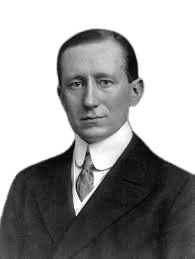Life and achievements
Early life
Guglielmo Giovanni Maria Marconi was born on April 25, 1874, in Bologna, Italy, to Giuseppe Marconi, a northerner Italian, and Annie Jameson, an Irish woman. His father was an Italian nobleman with the land, while his mother was Irish; thus, he was raised in a mixed Italian-Irish family. The early years of Marconi's life were not joyful, but he was fond of science and technology, especially electricity, which would be his future salvation.
Marconi's education was unconventional. He did not attend formal school but studied chemistry, mathematics, and physics at home. First, he was acquainted with scientific literature and experiments, which significantly influenced his inventive thinking. Among the people who had the most influence in his early life, it is possible to mention a teacher named Vincenzo Rosa, who introduced him to the principles of physics and electricity. Marconi entered the field of radio waves when he was 18 years old after the works of Heinrich Hertz and Oliver Lodge.
Marconi started his first wireless telegraphy transmission in 1894 in the attic of his house in Villa Griffone. He toiled and came up with the rudimentary of a wireless communication system, which was to be a foundation. Marconi's early work was to enhance the coherer, a simple radio signal receiver, to make it more effective. It is possible to consider these experiments as the beginning of Marconi's great path that would lead to the change of the communication world.
By 1895, Marconi could send wireless signals up to a distance of 2.5 kilometres. This was a great accomplishment because it demonstrated that wireless communication was feasible and could be used in practice. This encouraged Marconi to seek more and better recognition, and this is why he moved to England in 1896. In England, he received all the assistance and materials to apply for a patent and introduce his invention to the public.
Legacy
Marconi left a great legacy because his invention is the basis of present-day wireless communication. He played a great role in the development of radio telegraphy in the shipping, military, and broadcasting industries. Marconi's inventions and wireless communication applications in the commercial world altered long-distance communication and made the world a more connected place.
Marconi's contributions and inventions in science and technology were recognized globally and have earned several awards. In 1909, he and Karl Ferdinand Braun were awarded the Nobel Prize in Physics for their work in wireless telegraphy. In addition to being an inventor, Marconi was a businessman who initiated the Marconi Company, one of the earliest companies in the radio and wireless communication business.
However, political activity also played an essential role in Marconi's life. He became a member of the National Fascist Party of Italy, and Mussolini appointed him President of the Royal Academy of Puerto Rico. Fascism is topical in the history of science, politics, and ethical systems. However, he made a significant contribution to wireless communication; even today, his work influences the world.
Marconi's inventions paved the way for other communication gadgets and technologies like television, mobile phones, and the Internet. His vision and determination of how science can transform the world and the future of the world for the better. Today, Marconi is considered one of the most significant figures who bridged the gap between theoretical science and its application, which led to the development of contemporary communication.
Milestone moments
Dec 17, 1895
First Wireless Transmission
Marconi could transmit wireless signals to a distance of one and a half kilometres. This breakthrough proved that it was possible to have wireless communication.
Marconi employed an enhanced version of the coherer, an elementary radio signal detector, for the experiment.
Marconi achieved most of his early work in his house at Villa Griffone and started wireless communication.
This was the beginning of Marconi's transformation of communication.
He desired more and more achievements and fame in the scientific society.
Jun 17, 1896
The First Patent Filed
Marconi filed the first patent for wireless telegraphy in England for a device that he named "Improvements in Transmitting Electrical Impulses and Signals, and in Apparatus therefor."
Obtaining the patent was a strategic move for Marconi, particularly in developing wireless telegraphy.
The patent was a certificate that defined Marconi as an inventor of wireless communication.
It also allowed Marconi to demonstrate his invention to the British government and potential investors.
Dec 17, 1901
First Transatlantic Signal
Marconi sent the first transatlantic radio signal from Poldhu in Cornwall to St John's in Newfoundland. This event showed that wireless signals could be transmitted over vast distances over the sea.
It was a Morse code, and the signal was for the letter S, although it was relatively weak.
This feat brought Marconi into the limelight, and he was awarded the title of one of the greatest inventors of the last quarter of the nineteenth and the first quarter of the twentieth centuries.
This enabled wireless communication to be shown as viable for creating global networks.
Jan 17, 1903
Message from President Roosevelt
Marconi sent the first transatlantic radio message from the President of the United States, Theodore Roosevelt, to the King of England, Edward VII. This event showed that telegraph messages could be sent through wireless telegraphy across different countries.
The successful transmission proved that Marconi's wireless system was the best and most efficient.
It proposed applying wireless technology in diplomacy and other government-related activities.
This accomplishment only put Marconi in the Hall of Fame as one of the great inventors of wireless communication.
